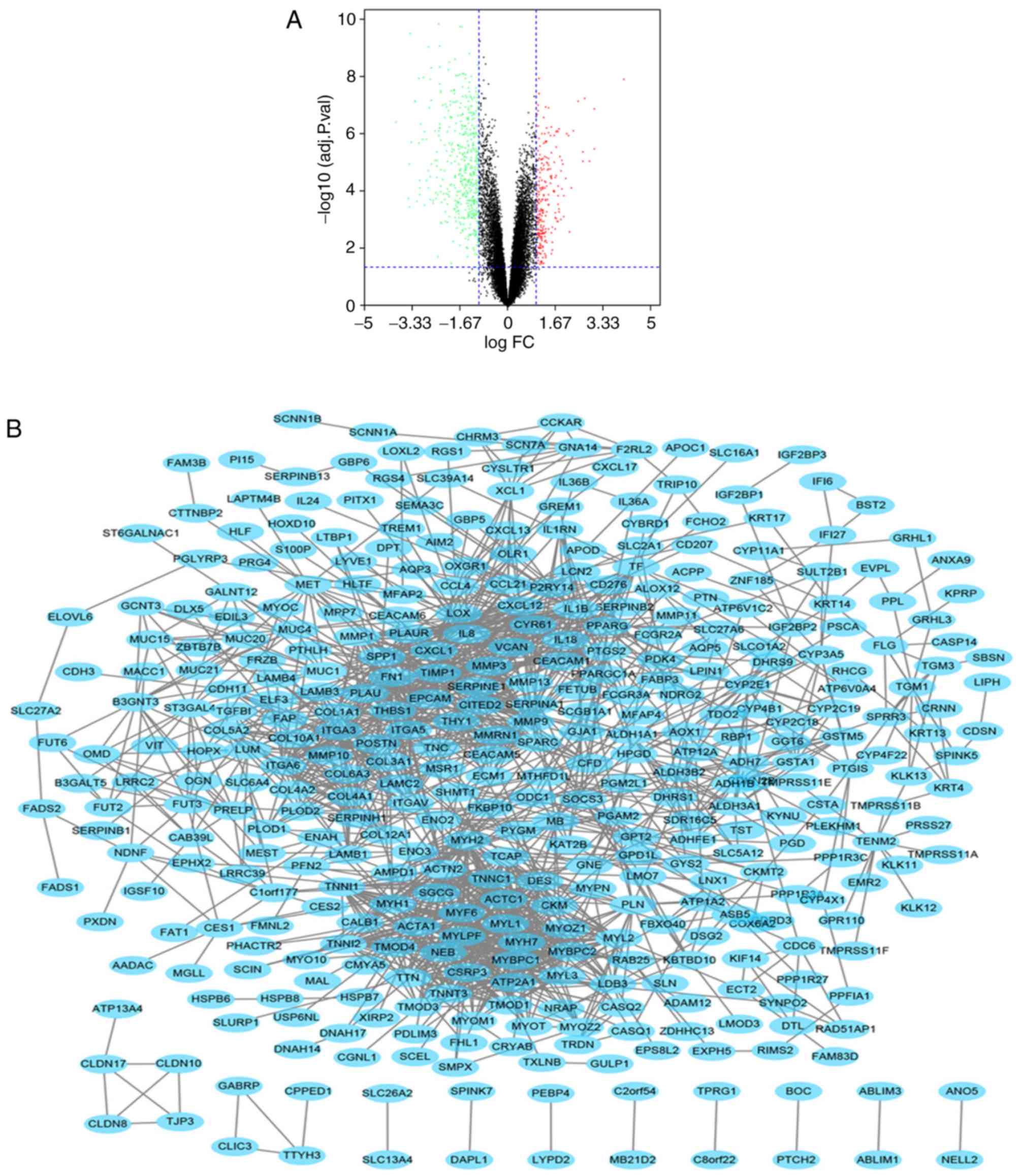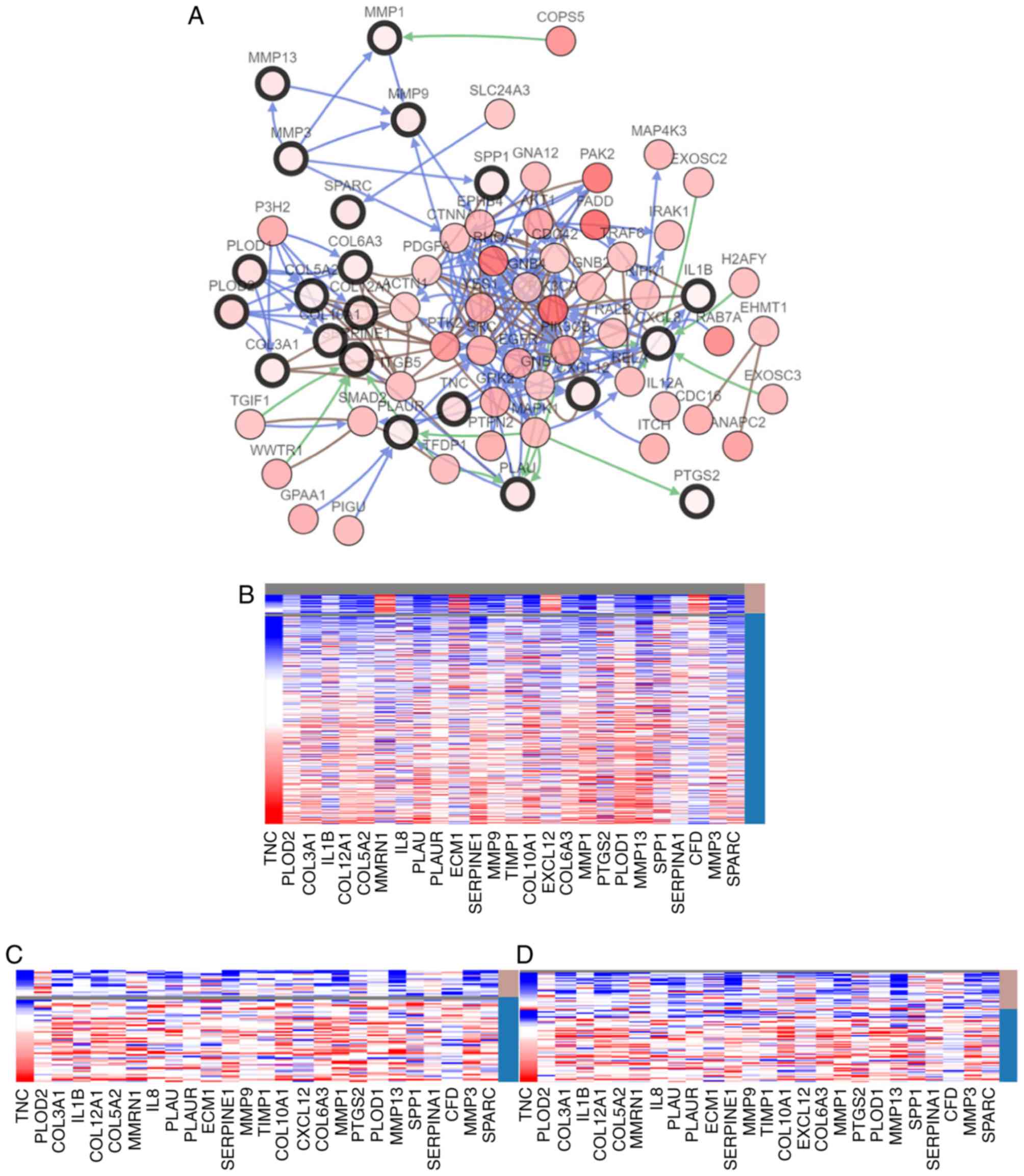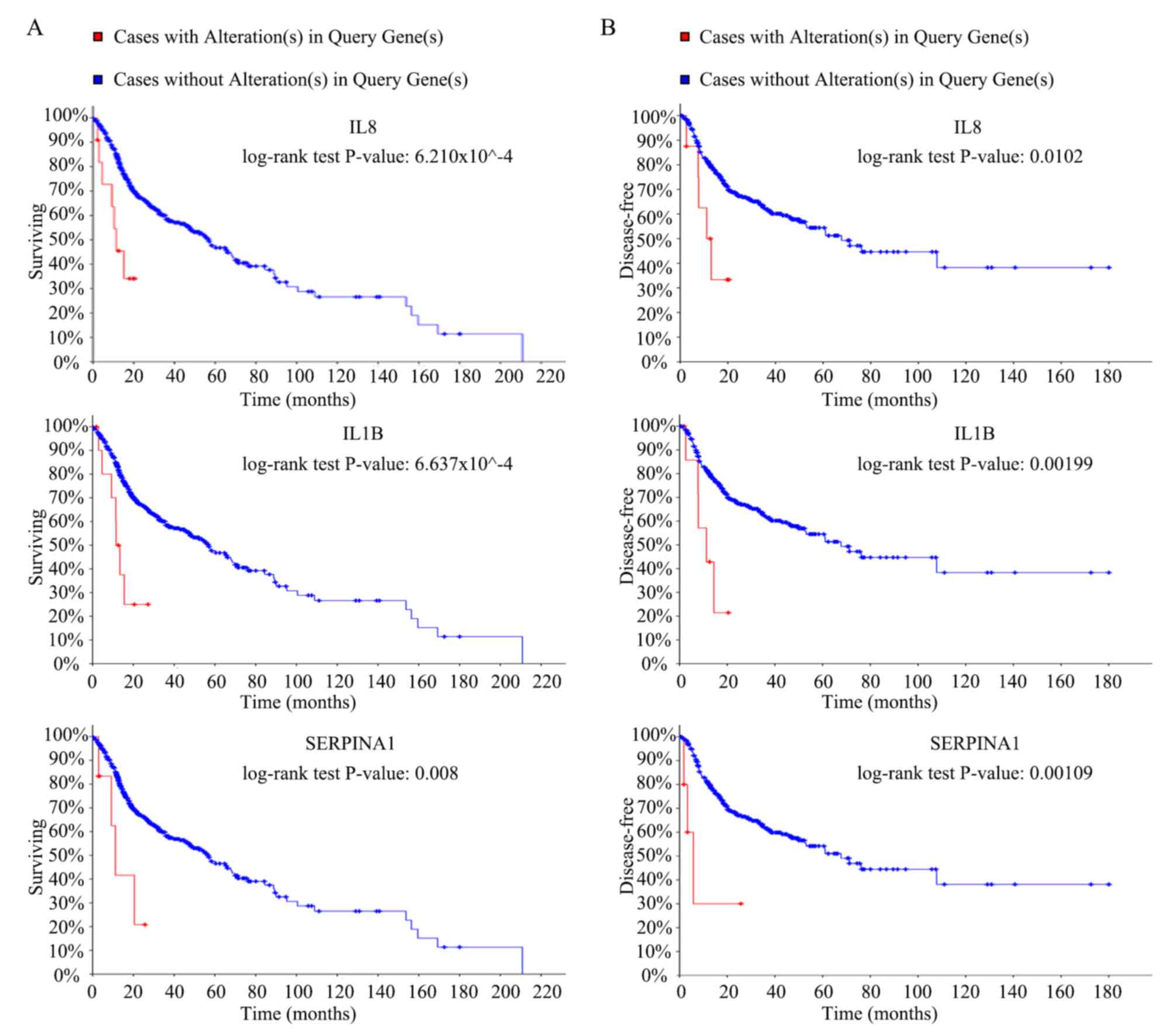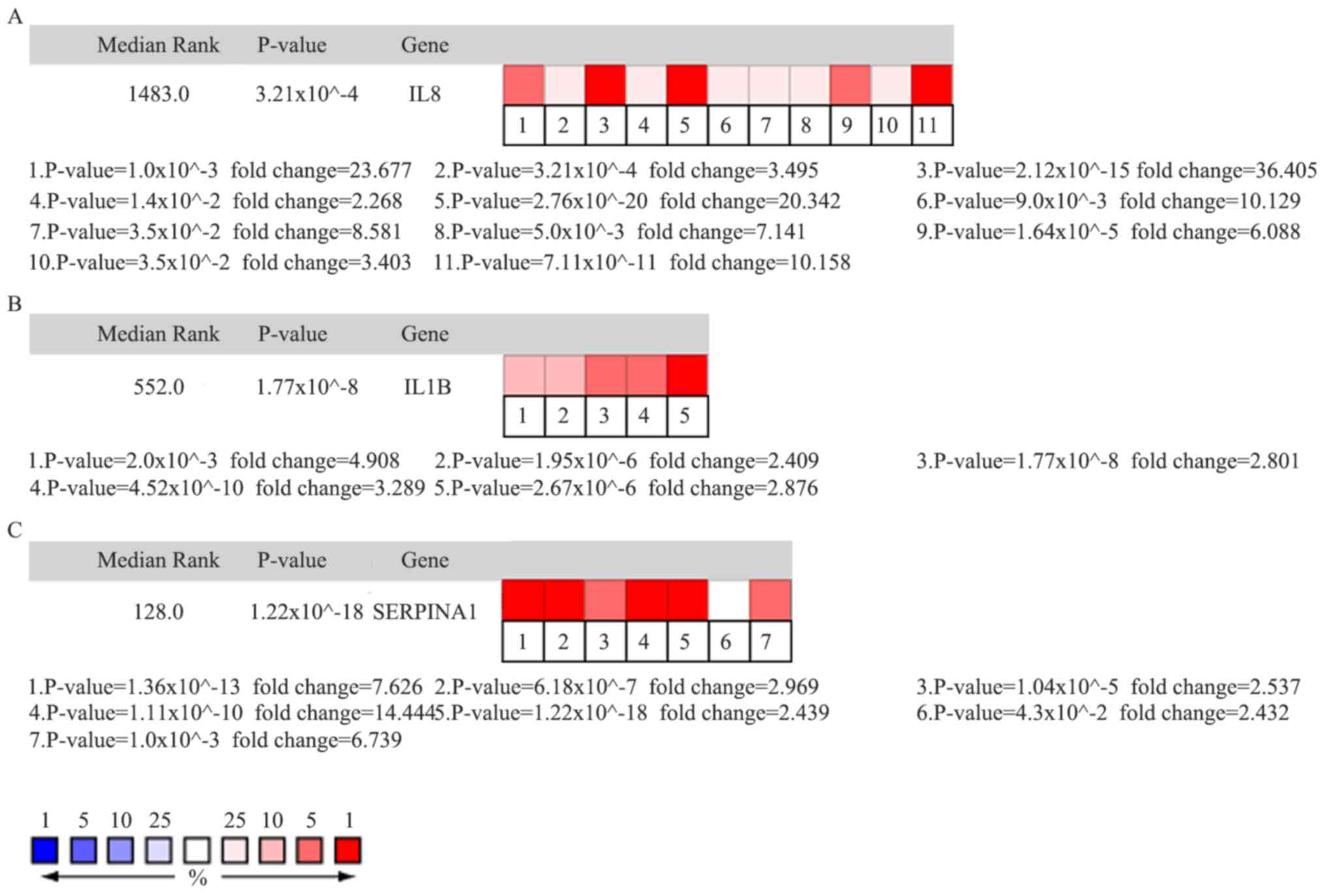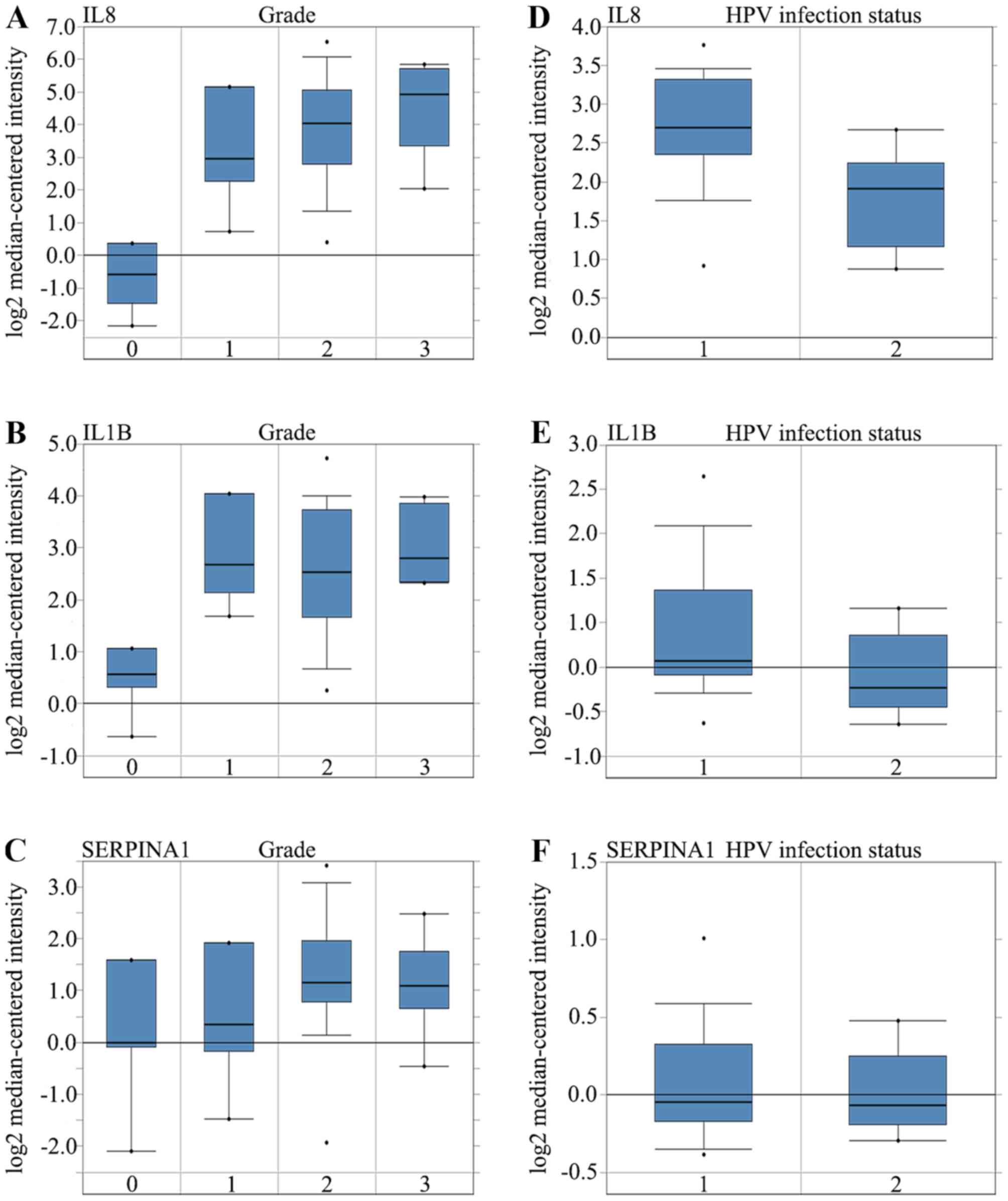|
1
|
Jemal A, Bray F, Center MM, Ferlay J, Ward
E and Forman D: Global cancer statistics. CA Cancer J Clin.
61:69–90. 2011. View Article : Google Scholar : PubMed/NCBI
|
|
2
|
Torre LA, Bray F, Siegel RL, Ferlay J,
Lortet-Tieulent J and Jemal A: Global cancer statistics, 2012. CA
Cancer J Clin. 65:87–108. 2015. View Article : Google Scholar : PubMed/NCBI
|
|
3
|
Bray F, Ferlay J, Laversanne M, Brewster
DH, Gombe MC, Kohler B, Piñeros M, Steliarova-Foucher E,
Swaminathan R, Antoni S, et al: cancer incidence in five
continents: Inclusion criteria, highlights from volume X and the
global status of cancer registration. Int J Cancer. 137:2060–2071.
2015. View Article : Google Scholar : PubMed/NCBI
|
|
4
|
Thibodeau BJ, Geddes TJ, Fortier LE, Ahmed
S, Pruetz BL, Wobb J, Chen P, Wilson GD and Akervall JA: Gene
expression characterization of HPV positive head and neck cancer to
predict response to chemoradiation. Head Neck Pathol. 9:345–353.
2015. View Article : Google Scholar : PubMed/NCBI
|
|
5
|
Min SK, Lee SK, Park JS, Lee J, Paeng JY,
Lee SI, Lee HJ, Kim Y, Pae HO, Lee SK and Kim EC: Endoplasmic
reticulum stress is involved in hydrogen peroxide induced apoptosis
in immortalized and malignant human oral keratinocytes. J Oral
Pathol Med. 37:490–498. 2008. View Article : Google Scholar : PubMed/NCBI
|
|
6
|
Skvortsov S, Dudás J, Eichberger P,
Witsch-Baumgartner M, Loeffler-Ragg J, Pritz C, Schartinger VH,
Maier H, Hall J, Debbage P, et al: Rac1 as a potential therapeutic
target for chemo-radioresistant head and neck squamous cell
carcinomas (HNSCC). Br J Cancer. 110:2677–2687. 2014. View Article : Google Scholar : PubMed/NCBI
|
|
7
|
Wang Y, Chen C, Wang X, Jin F, Liu Y, Liu
H, Li T and Fu J: Lower DSC1 expression is related to the poor
differentiation and prognosis of head and neck squamous cell
carcinoma (HNSCC). J Cancer Res Clin Oncol. 142:2461–2468. 2016.
View Article : Google Scholar : PubMed/NCBI
|
|
8
|
Edgar R, Domrachev M and Lash AE: Gene
expression omnibus: NCBI gene expression and hybridization array
data repository. Nucleic Acids Res. 30:207–210. 2002. View Article : Google Scholar : PubMed/NCBI
|
|
9
|
Barrett T, Wilhite SE, Ledoux P,
Evangelista C, Kim IF, Tomashevsky M, Marshall KA, Phillippy KH,
Sherman PM, Holko M, et al: NCBI GEO: Archive for functional
genomics data sets-update. Nucleic Acids Res 41 (Database Issue).
D991–D995. 2013.
|
|
10
|
Lobert S, Graichen ME, Hamilton RD, Pitman
KT, Garrett MR, Hicks C and Koganti T: Prognostic biomarkers for
HNSCC using quantitative real-time PCR and microarray analysis:
β-tubulin isotypes and the p53 interactome. Cytoskeleton (Hoboken).
71:628–637. 2014. View
Article : Google Scholar : PubMed/NCBI
|
|
11
|
Huang DW, Sherman BT, Tan Q, Collins JR,
Alvord WG, Roayaei J, Stephens R, Baseler MW, Lane HC and Lempicki
RA: The DAVID gene functional classification tool: A novel
biological module-centric algorithm to functionally analyze large
gene lists. Genome Biol. 8:R1832007. View Article : Google Scholar : PubMed/NCBI
|
|
12
|
Kanehisa M, Sato Y, Kawashima M, Furumichi
M and Tanabe M: KEGG as a reference resource for gene and protein
annotation. Nucleic Acids Res. 44(D1): D457–D462. 2016. View Article : Google Scholar : PubMed/NCBI
|
|
13
|
Pinoli P, Chicco D and Masseroli M:
Computational algorithms to predict gene ontology annotations. BMC
Bioinformatics. 16 (Suppl 6):S42015. View Article : Google Scholar : PubMed/NCBI
|
|
14
|
Szklarczyk D, Franceschini A, Wyder S,
Forslund K, Heller D, Huerta-Cepas J, Simonovic M, Roth A, Santos
A, Tsafou KP, et al: STRING v10: Protein-protein interaction
networks, integrated over the tree of life. Nucleic Acids Res 43
(Database issue). D447–D452. 2015. View Article : Google Scholar
|
|
15
|
Su G, Morris JH, Demchak B and Bader GD:
Biological network exploration with Cytoscape 3. Curr Protoc
Bioinformatics. 47:8.13.1–24. 2014. View Article : Google Scholar
|
|
16
|
Bandettini WP, Kellman P, Mancini C,
Booker OJ, Vasu S, Leung SW, Wilson JR, Shanbhag SM, Chen MY and
Arai AE: Multi contrast delayed enhancement (MCODE) improves
detection of subendocardial myocardial infarction by late
gadolinium enhancement cardiovascular magnetic resonance: A
clinical validation study. J Cardiovasc Magn Reson. 14:832012.
View Article : Google Scholar : PubMed/NCBI
|
|
17
|
Gao J, Aksoy BA, Dogrusoz U, Dresdner G,
Gross B, Sumer SO, Sun Y, Jacobsen A, Sinha R, Larsson E, et al:
Integrative analysis of complex cancer genomics and clinical
profiles using the cBioPortal. Sci Signal. 6:pl12013. View Article : Google Scholar : PubMed/NCBI
|
|
18
|
Cerami E, Gao J, Dogrusoz U, Gross BE,
Sumer SO, Aksoy BA, Jacobsen A, Byrne CJ, Heuer ML, Larsson E, et
al: The cBio cancer genomics portal: An open platform for exploring
multidimensional cancer genomics data. Cancer Discov. 2:401–404.
2012. View Article : Google Scholar : PubMed/NCBI
|
|
19
|
Rosenbloom KR, Armstrong J, Barber GP,
Casper J, Clawson H, Diekhans M, Dreszer TR, Fujita PA, Guruvadoo
L, Haeussler M, et al: The UCSC Genome Browser database: 2015
update. Nucleic Acids Res 43 (Database Issue). D670–D681. 2015.
View Article : Google Scholar
|
|
20
|
Rhodes DR, Yu J, Shanker K, Deshpande N,
Varambally R, Ghosh D, Barrette T, Pandey A and Chinnaiyan AM:
ONCOMINE: A cancer microarray database and integrated data-mining
platform. Neoplasia. 6:1–6. 2004. View Article : Google Scholar : PubMed/NCBI
|
|
21
|
Cromer A, Carles A, Millon R, Ganguli G,
Chalmel F, Lemaire F, Young J, Dembélé D, Thibault C, Muller D, et
al: Identification of genes associated with tumorigenesis and
metastatic potential of hypopharyngeal cancer by microarray
analysis. Oncogene. 23:2484–2498. 2004. View Article : Google Scholar : PubMed/NCBI
|
|
22
|
Estilo CL, O-charoenrat P, Talbot S, Socci
ND, Carlson DL, Ghossein R, Williams T, Yonekawa Y, Ramanathan Y,
Boyle JO, et al: Oral tongue cancer gene expression profiling:
Identification of novel potential prognosticators by
oligonucleotide microarray analysis. BMC Cancer. 9:112009.
View Article : Google Scholar : PubMed/NCBI
|
|
23
|
Ginos MA, Page GP, Michalowicz BS, Patel
KJ, Volker SE, Pambuccian SE, Ondrey FG, Adams GL and Gaffney PM:
Identification of a gene expression signature associated with
recurrent disease in squamous cell carcinoma of the head and neck.
Cancer Res. 64:55–63. 2004. View Article : Google Scholar : PubMed/NCBI
|
|
24
|
He H, Jazdzewski K, Li W, Liyanarachchi S,
Nagy R, Volinia S, Calin GA, Liu CG, Franssila K, Suster S, et al:
The role of microRNA genes in papillary thyroid carcinoma. Proc
Natl Acad Sci USA. 102:19075–19080. 2005. View Article : Google Scholar : PubMed/NCBI
|
|
25
|
Peng CH, Liao CT, Peng SC, Chen YJ, Cheng
AJ, Juang JL, Tsai CY, Chen TC, Chuang YJ, Tang CY, et al: A novel
molecular signature identified by systems genetics approach
predicts prognosis in oral squamous cell carcinoma. PLoS One.
6:e234522011. View Article : Google Scholar : PubMed/NCBI
|
|
26
|
Pyeon D, Newton MA, Lambert PF, den Boon
JA, Sengupta S, Marsit CJ, Woodworth CD, Connor JP, Haugen TH,
Smith EM, et al: Fundamental differences in cell cycle deregulation
in human papillomavirus-positive and human papillomavirus-negative
head/neck and cervical cancers. Cancer Res. 67:4605–4619. 2007.
View Article : Google Scholar : PubMed/NCBI
|
|
27
|
Ye H, Yu T, Temam S, Ziober BL, Wang J,
Schwartz JL, Mao L, Wong DT and Zhou X: Transcriptomic dissection
of tongue squamous cell carcinoma. BMC Genomics. 9:692008.
View Article : Google Scholar : PubMed/NCBI
|
|
28
|
Giordano TJ, Au AY, Kuick R, Thomas DG,
Rhodes DR, Wilhelm KJ Jr, Vinco M, Misek DE, Sanders D, Zhu Z, et
al: Delineation, functional validation, and bioinformatic
evaluation of gene expression in thyroid follicular carcinomas with
the PAX8-PPARG translocation. Clin Cancer Res. 12:1983–1993. 2006.
View Article : Google Scholar : PubMed/NCBI
|
|
29
|
Vasko V, Espinosa AV, Scouten W, He H,
Auer H, Liyanarachchi S, Larin A, Savchenko V, Francis GL, de la
Chapelle A, et al: Gene expression and functional evidence of
epithelial-to-mesenchymal transition in papillary thyroid carcinoma
invasion. Proc Natl Acad Sci USA. 104:2803–2808. 2007. View Article : Google Scholar : PubMed/NCBI
|
|
30
|
Forastiere A, Koch W, Trotti A and
Sidransky D: Head and neck cancer. N Engl J Med. 345:1890–900.
2001. View Article : Google Scholar : PubMed/NCBI
|
|
31
|
Bozec A, Ilie M, Dassonville O, Long E,
Poissonnet G, Santini J, Chamorey E, Ettaiche M, Chauviere D,
Peyrade F, et al: Significance of circulating tumor cell detection
using the Cell search system in patients with locally advanced head
and neck squamous cell carcinoma. Eur Arch Otorhinolaryngol.
270:2745–2749. 2013. View Article : Google Scholar : PubMed/NCBI
|
|
32
|
Rettig EM and D'Souza G: Epidemiology of
head and neck cancer. Surg Oncol Clin N Am. 24:379–396. 2015.
View Article : Google Scholar : PubMed/NCBI
|
|
33
|
Marullo R, Werner E, Zhang H, Chen GZ,
Shin DM and Doetsch PW: HPV16 E6 and E7 proteins induce a chronic
oxidative stress response via NOX2 that causes genomic instability
and increased susceptibility to DNA damage in head and neck cancer
cells. Carcinogenesis. 36:1397–1406. 2015. View Article : Google Scholar : PubMed/NCBI
|
|
34
|
Boscolo-Rizzo P, Zorzi M, Del Mistro A, Da
Mosto MC, Tirelli G, Buzzoni C, Rugge M, Polesel J and Guzzinati S;
AIRTUM Working Group, : The evolution of the epidemiological
landscape of head and neck cancer in Italy: Is there evidence for
an increase in the incidence of potentially HPV-related carcinomas?
PLoS One. 13:e01926212018. View Article : Google Scholar : PubMed/NCBI
|
|
35
|
Cheraghlou S, Torabi SJ, Husain ZA,
Otremba MD, Osborn HA, Mehra S, Yarbrough WG, Burtness BA and
Judson BL: HPV status in unknown primary head and neck cancer:
Prognosis and treatment outcomes. Laryngoscope. 129:684–691. 2019.
View Article : Google Scholar : PubMed/NCBI
|
|
36
|
Kreimer AR, Clifford GM, Boyle P and
Franceschi S: Human papillomavirus types in head and neck squamous
cell carcinomas worldwide: A systematic review. Cancer Epidemiol
Biomarkers Prev. 14:467–475. 2005. View Article : Google Scholar : PubMed/NCBI
|
|
37
|
Wu X, Cao W, Wang X, Zhang J, Lv Z, Qin X,
Wu Y and Chen W: TGM3, a candidate tumor suppressor gene,
contributes to human head and neck cancer. Mol Cancer. 12:1512013.
View Article : Google Scholar : PubMed/NCBI
|
|
38
|
Masui T, Ota I, Itaya-Hironaka A, Takeda
M, Kasai T, Yamauchi A, Sakuramoto-Tsuchida S, Mikami S, Yane K,
Takasawa S and Hosoi H: Expression of REG III and prognosis in head
and neck cancer. Oncol Rep. 30:573–578. 2013. View Article : Google Scholar : PubMed/NCBI
|
|
39
|
Andratschke M, Hagedorn H and Nerlich A:
Expression of the epithelial cell adhesion molecule and cytokeratin
8 in head and neck squamous cell cancer: A comparative study.
Anticancer Res. 35:3953–3960. 2015.PubMed/NCBI
|
|
40
|
Squarize CH, Castilho RM, Abrahao AC,
Molinolo A, Lingen MW and Gutkind JS: PTEN deficiency contributes
to the development and progression of head and neck cancer.
Neoplasia. 15:461–471. 2013. View Article : Google Scholar : PubMed/NCBI
|
|
41
|
Gross AM, Orosco RK, Shen JP, Egloff AM,
Carter H, Hofree M, Choueiri M, Coffey CS, Lippman SM, Hayes DN, et
al: Multi-tiered genomic analysis of head and neck cancer ties TP53
mutation to 3p loss. Nat Genet. 46:939–943. 2014. View Article : Google Scholar : PubMed/NCBI
|
|
42
|
Psyrri A, Seiwert TY and Jimeno A:
Molecular pathways in head and neck cancer: EGFR, PI3K, and more.
Am Soc Clin Oncol Educ Book. 246–255. 2013. View Article : Google Scholar : PubMed/NCBI
|
|
43
|
Mahjabeen I, Baig RM, Masood N, Sabir M,
Inayat U, Malik FA and Kayani MA: Genetic variations in XRCC1 gene
in sporadic head and neck cancer (HNC) patients. Pathol Oncol Res.
19:183–188. 2013. View Article : Google Scholar : PubMed/NCBI
|
|
44
|
Boeckx C, Weyn C, Vanden Bempt I,
Deschoolmeester V, Wouters A, Specenier P, Van Laer C, Van den
Weyngaert D, Kockx M, Vermorken JB, et al: Mutation analysis of
genes in the EGFR pathway in Head and Neck cancer patients:
Implications for anti-EGFR treatment response. BMC Res Notes.
7:3372014. View Article : Google Scholar : PubMed/NCBI
|
|
45
|
Gilkes DM, Semenza GL and Wirtz D: Hypoxia
and the extracellular matrix: Drivers of tumour metastasis. Nat Rev
Cancer. 14:430–439. 2014. View Article : Google Scholar : PubMed/NCBI
|
|
46
|
Malik R, Lelkes PI and Cukierman E:
Biomechanical and biochemical remodeling of stromal extracellular
matrix in cancer. Trends Biotechnol. 33:230–236. 2015. View Article : Google Scholar : PubMed/NCBI
|
|
47
|
Trulsson M, Yu H, Gisselsson L, Chao Y,
Urbano A, Aits S, Mossberg AK and Svanborg C: HAMLET binding to
α-actinin facilitates tumor cell detachment. PLoS One.
6:e171792011. View Article : Google Scholar : PubMed/NCBI
|
|
48
|
Zhang HJ, Tao J, Sheng L, Hu X, Rong RM,
Xu M and Zhu TY: Twist2 promotes kidney cancer cell proliferation
and invasion by regulating ITGA6 and CD44 expression in the
ECM-receptor interaction pathway. Onco Targets Ther. 9:1801–1812.
2016.PubMed/NCBI
|
|
49
|
Eke I and Cordes N: Focal adhesion
signaling and therapy resistance in cancer. Semin Cancer Biol.
31:65–75. 2015. View Article : Google Scholar : PubMed/NCBI
|
|
50
|
Blackstone BN, Li R, Ackerman WT, Ghadiali
SN, Powell HM and Kniss DA: Myoferlin depletion elevates focal
adhesion kinase and paxillin phosphorylation and enhances
cell-matrix adhesion in breast cancer cells. Am J Physiol Cell
Physiol. 308:C642–C649. 2015. View Article : Google Scholar : PubMed/NCBI
|
|
51
|
Johnson AL, Edson KZ, Totah RA and Rettie
AE: Cytochrome P450 ω-hydroxylases in inflammation and cancer. Adv
Pharmacol. 74:223–262. 2015. View Article : Google Scholar : PubMed/NCBI
|
|
52
|
Ravegnini G, Sammarini G, Hrelia P and
Angelini S: Key genetic and epigenetic mechanisms in chemical
carcinogenesis. Toxicol Sci. 148:2–13. 2015. View Article : Google Scholar : PubMed/NCBI
|
|
53
|
Van Damme J, Rampart M, Conings R, Decock
B, Van Osselaer N, Willems J and Billiau A: The
neutrophil-activating proteins interleukin 8 and
beta-thromboglobulin: In vitro and in vivo comparison of
NH2-terminally processed forms. Eur J Immunol. 20:2113–2118. 1990.
View Article : Google Scholar : PubMed/NCBI
|
|
54
|
Lo MC, Yip TC, Ngan KC, Cheng WW, Law CK,
Chan PS, Chan KC, Wong CK, Wong RN, Lo KW, et al: Role of
MIF/CXCL8/CXCR2 signaling in the growth of nasopharyngeal carcinoma
tumor spheres. Cancer Lett. 335:81–92. 2013. View Article : Google Scholar : PubMed/NCBI
|
|
55
|
Chan LP, Wang LF, Chiang FY, Lee KW, Kuo
PL and Liang CH: IL-8 promotes HNSCC progression on
CXCR1/2-meidated NOD1/RIP2 signaling pathway. Oncotarget.
7:61820–61831. 2016. View Article : Google Scholar : PubMed/NCBI
|
|
56
|
Christofakis EP, Miyazaki H, Rubink DS and
Yeudall WA: Roles of CXCL8 in squamous cell carcinoma proliferation
and migration. Oral Oncol. 44:920–926. 2008. View Article : Google Scholar : PubMed/NCBI
|
|
57
|
Curry JM, Sprandio J, Cognetti D,
Luginbuhl A, Bar-ad V, Pribitkin E and Tuluc M: Tumor
microenvironment in head and neck squamous cell carcinoma. Semin
Oncol. 41:217–234. 2014. View Article : Google Scholar : PubMed/NCBI
|
|
58
|
Fang W, Ye L, Shen L, Cai J, Huang F, Wei
Q, Fei X, Chen X, Guan H, Wang W, et al: Tumor-associated
macrophages promote the metastatic potential of thyroid papillary
cancer by releasing CXCL8. Carcinogenesis. 35:1780–1787. 2014.
View Article : Google Scholar : PubMed/NCBI
|
|
59
|
Tominaga K, Yoshimoto T, Torigoe K,
Kurimoto M, Matsui K, Hada T, Okamura H and Nakanishi K: IL-12
synergizes with IL-18 or IL-1beta for IFN-gamma production from
human T cells. Int Immunol. 12:151–160. 2000. View Article : Google Scholar : PubMed/NCBI
|
|
60
|
Stanam A, Gibson-Corley KN, Love-Homan L,
Ihejirika N and Simons AL: Interleukin-1 blockade overcomes
erlotinib resistance in head and neck squamous cell carcinoma.
Oncotarget. 7:76087–76100. 2016. View Article : Google Scholar : PubMed/NCBI
|
|
61
|
Kim HS, Kwon HJ, Jung I, Yun MR, Ahn MJ,
Kang BW, Sun JM, Kim SB, Yoon DH, Park KU, et al: Phase II clinical
and exploratory biomarker study of dacomitinib in patients with
recurrent and/or metastatic squamous cell carcinoma of head and
neck. Clin Cancer Res. 21:544–552. 2015. View Article : Google Scholar : PubMed/NCBI
|
|
62
|
Kwon CH, Park HJ, Choi JH, Lee JR, Kim HK,
Jo HJ, Kim HS, Oh N, Song GA and Park DY: Snail and serpinA1
promote tumor progression and predict prognosis in colorectal
cancer. Oncotarget. 6:20312–20326. 2015. View Article : Google Scholar : PubMed/NCBI
|
|
63
|
Kawahara R, Bollinger JG, Rivera C,
Ribeiro AC, Brandão TB, Paes Leme AF and MacCoss MJ: A targeted
proteomic strategy for the measurement of oral cancer candidate
biomarkers in human saliva. Proteomics. 16:159–173. 2016.
View Article : Google Scholar : PubMed/NCBI
|
|
64
|
Qu T, Li YP, Li XH and Chen Y:
Identification of potential biomarkers and drugs for papillary
thyroid cancer based on gene expression profile analysis. Mol Med
Rep. 14:5041–5048. 2016. View Article : Google Scholar : PubMed/NCBI
|
|
65
|
Vierlinger K, Mansfeld MH, Koperek O,
Nöhammer C, Kaserer K and Leisch F: Identification of SERPINA1 as
single marker for papillary thyroid carcinoma through microarray
meta analysis and quantification of its discriminatory power in
independent validation. BMC Med Genomics. 4:302011. View Article : Google Scholar : PubMed/NCBI
|
|
66
|
Fialka F, Gruber RM, Hitt R, Opitz L,
Brunner E, Schliephake H and Kramer FJ: CPA6, FMO2, LGI1, SIAT1 and
TNC are differentially expressed in early- and late-stage oral
squamous cell carcinoma-a pilot study. Oral Oncol. 44:941–948.
2008. View Article : Google Scholar : PubMed/NCBI
|
|
67
|
Renkonen S, Heikkilä P, Haglund C, Mäkitie
AA and Hagström J: Tenascin-C, GLUT-1, and syndecan-2 expression in
juvenile nasopharyngeal angiofibroma: Correlations to vessel
density and tumor stage. Head Neck. 35:1036–1042. 2013. View Article : Google Scholar : PubMed/NCBI
|
|
68
|
Qiu F, Sun R, Deng N, Guo T, Cao Y, Yu Y,
Wang X, Zou B, Zhang S, Jing T, et al: miR-29a/b enhances cell
migration and invasion in nasopharyngeal carcinoma progression by
regulating SPARC and COL3A1 gene expression. PLoS One.
10:e01209692015. View Article : Google Scholar : PubMed/NCBI
|
|
69
|
Suresh A, Vannan M, Kumaran D, Gümüs ZH,
Sivadas P, Murugaian EE, Kekatpure V, Iyer S, Thangaraj K and
Kuriakose MA: Resistance/response molecular signature for oral
tongue squamous cell carcinoma. Dis Markers. 32:51–64. 2012.
View Article : Google Scholar : PubMed/NCBI
|
|
70
|
Sepiashvili L, Hui A, Ignatchenko V, Shi
W, Su S, Xu W, Huang SH, O'Sullivan B, Waldron J, Irish JC, et al:
Potentially novel candidate biomarkers for head and neck squamous
cell carcinoma identified using an integrated cell line-based
discovery strategy. Mol Cell Proteomics. 11:1404–1415. 2012.
View Article : Google Scholar : PubMed/NCBI
|
|
71
|
Gu M, Guan J, Zhao L, Ni K, Li X and Han
Z: Correlation of ECM1 expression level with the pathogenesis and
metastasis of laryngeal carcinoma. Int J Clin Exp Pathol.
6:1132–1137. 2013.PubMed/NCBI
|
|
72
|
Meng XY, Liu J, Lv F, Liu MQ and Wan JM:
Study on the correlation between extracellular matrix protein-1 and
the growth, metastasis and angiogenesis of laryngeal carcinoma.
Asian Pac J Cancer Prev. 16:2313–2316. 2015. View Article : Google Scholar : PubMed/NCBI
|
|
73
|
Pavón MA, Arroyo-Solera I, Céspedes MV,
Casanova I, León X and Mangues R: uPA/uPAR and SERPINE1 in head and
neck cancer: Role in tumor resistance, metastasis, prognosis and
therapy. Oncotarget. 7:57351–57366. 2016. View Article : Google Scholar : PubMed/NCBI
|
|
74
|
Pavón MA, Arroyo-Solera I, Téllez-Gabriel
M, León X, Virós D, López M, Gallardo A, Céspedes MV, Casanova I,
López-Pousa A, et al: Enhanced cell migration and apoptosis
resistance may underlie the association between high SERPINE1
expression and poor outcome in head and neck carcinoma patients.
Oncotarget. 6:29016–29033. 2015. View Article : Google Scholar : PubMed/NCBI
|
|
75
|
Van Tubergen EA, Banerjee R, Liu M, Vander
Broek R, Light E, Kuo S, Feinberg SE, Willis AL, Wolf G, Carey T,
et al: Inactivation or loss of TTP promotes invasion in head and
neck cancer via transcript stabilization and secretion of MMP9,
MMP2, and IL-6. Clin Cancer Res. 19:1169–1179. 2013. View Article : Google Scholar : PubMed/NCBI
|
|
76
|
Pietruszewska W, Bojanowska-Poźniak K and
Kobos J: Matrix metalloproteinases MMP1, MMP2, MMP9 and their
tissue inhibitors TIMP1, TIMP2, TIMP3 in head and neck cancer: An
immunohistochemical study. Otolaryngol Pol. 70:32–43. 2016.
View Article : Google Scholar : PubMed/NCBI
|
|
77
|
Zhang C, Li C, Zhu M, Zhang Q, Xie Z, Niu
G, Song X, Jin L, Li G and Zheng H: Meta-analysis of MMP2, MMP3,
and MMP9 promoter polymorphisms and head and neck cancer risk. PLoS
One. 8:e620232013. View Article : Google Scholar : PubMed/NCBI
|
|
78
|
Vincent-Chong VK, Salahshourifar I,
Karen-Ng LP, Siow MY, Kallarakkal TG, Ramanathan A, Yang YH, Khor
GH, Rahman ZA, Ismail SM, et al: Overexpression of MMP13 is
associated with clinical outcomes and poor prognosis in oral
squamous cell carcinoma. ScientificWorldJournal. 2014:8975232014.
View Article : Google Scholar : PubMed/NCBI
|
|
79
|
Pradhan-Palikhe P, Vesterinen T, Tarkkanen
J, Leivo I, Sorsa T, Salo T and Mattila PS: Plasma level of tissue
inhibitor of matrix metalloproteinase-1 but not that of matrix
metalloproteinase-8 predicts survival in head and neck squamous
cell cancer. Oral Oncol. 46:514–518. 2010. View Article : Google Scholar : PubMed/NCBI
|
|
80
|
Huang CF, Yu GT, Wang WM, Liu B and Sun
ZJ: Prognostic and predictive values of SPP1, PAI and caveolin-1 in
patients with oral squamous cell carcinoma. Int J Clin Exp Pathol.
7:6032–6039. 2014.PubMed/NCBI
|
|
81
|
Aquino G, Sabatino R, Cantile M, Aversa C,
Ionna F, Botti G, La Mantia E, Collina F, Malzone G, Pannone G, et
al: Expression analysis of SPARC/osteonectin in oral squamous cell
carcinoma patients: From saliva to surgical specimen. Biomed Res
Int. 2013:7364382013. View Article : Google Scholar : PubMed/NCBI
|
|
82
|
Li L, Lei Q, Zhang S, Kong L and Qin B:
Screening and identification of key biomarkers in hepatocellular
carcinoma: Evidence from bioinformatic analysis. Oncol Rep.
38:2607–2618. 2017. View Article : Google Scholar : PubMed/NCBI
|
|
83
|
Saha SK, Jeong Y, Cho S and Cho SG:
Systematic expression alteration analysis of master reprogramming
factor OCT4 and its three pseudogenes in human cancer and their
prognostic outcomes. Sci Rep. 8:148062018. View Article : Google Scholar : PubMed/NCBI
|
|
84
|
Yang Y, Dong X, Xie B, Ding N, Chen J, Li
Y, Zhang Q, Qu H and Fang X: Databases and web tools for cancer
genomics study. Genomics Proteomics Bioinformatics. 13:46–50. 2015.
View Article : Google Scholar : PubMed/NCBI
|















